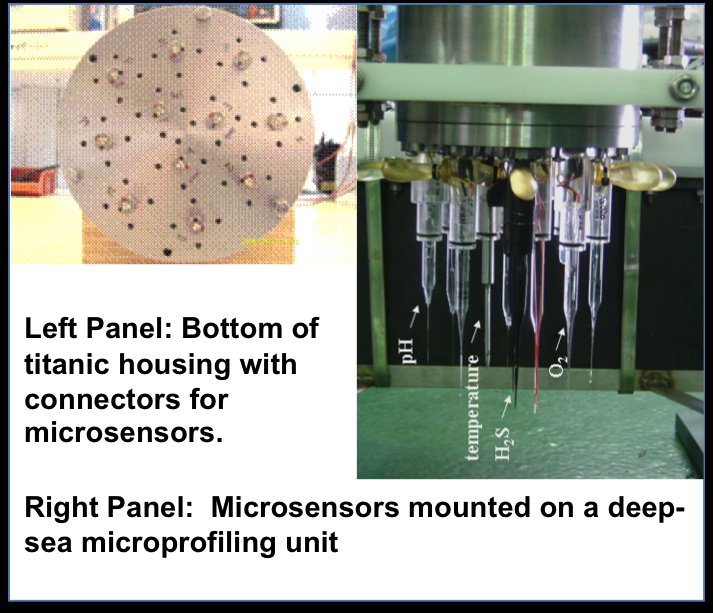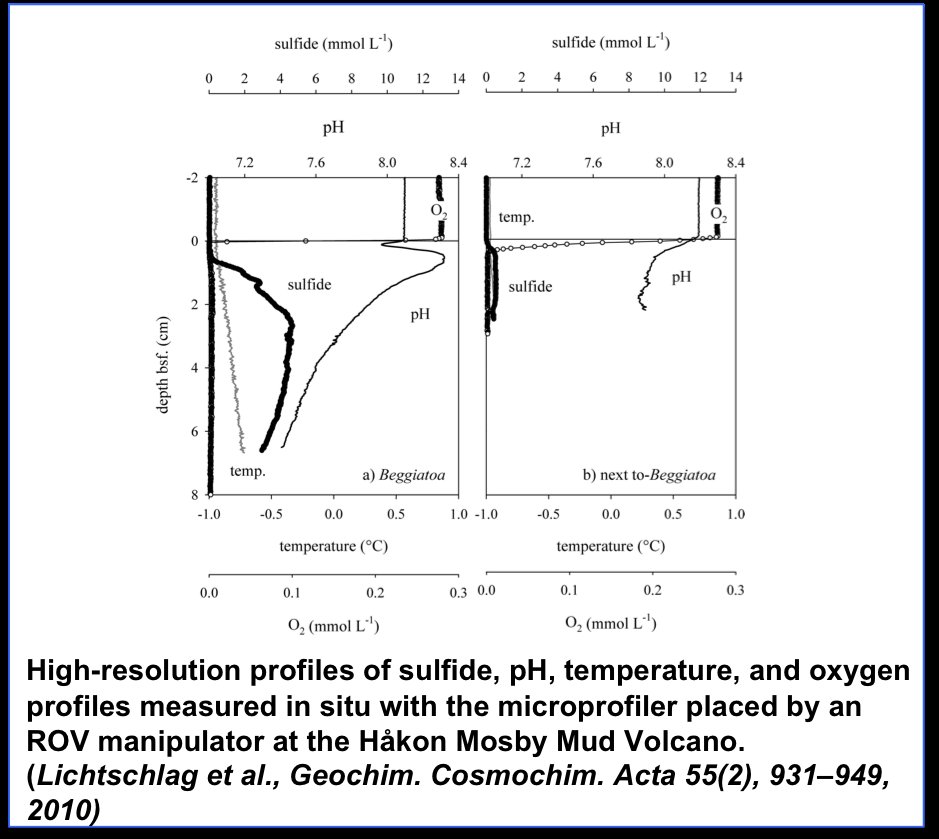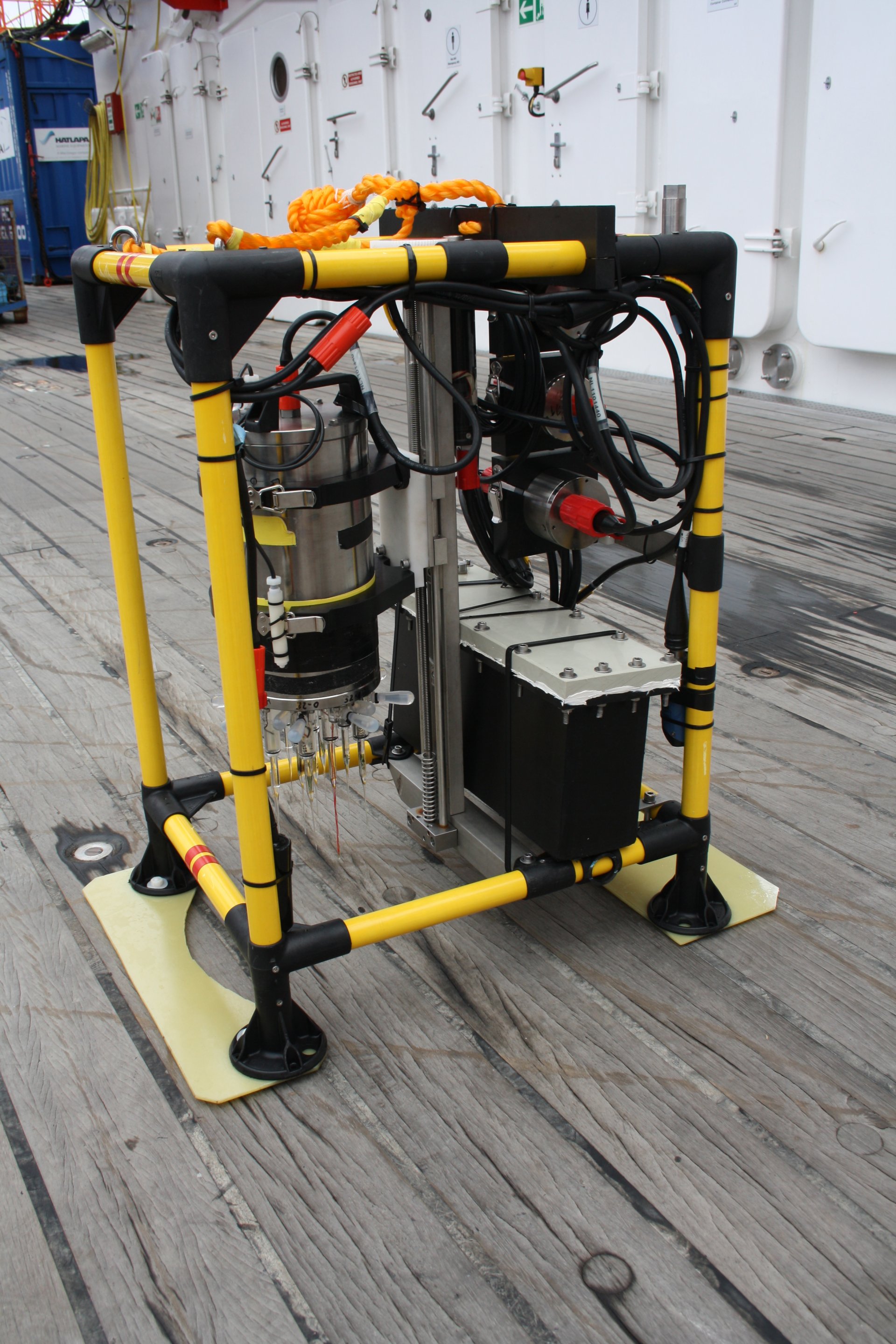Seitenpfad:
Microprofiler
Die Inhalte dieser Seite sind leider nicht auf Deutsch verfügbar.
Frank Wenzhöfer, Ralf Hoffmann, Felix Janssen, Volker Asendorf, Axel Nordhausen, Fabian Schramm
The sediment surface is characterized by steep gradients and an extensive spatial and temporal heterogeneity. Measurements with high temporal and spatial resolution are crucial for the understanding of early digenesis, microbe-environment interactions and benthic fluxes. Benthic microbial activity is limited by kinetics (availability of suitable microbes/enzymes, pH, T, and other microenvironmental factors) and by mass transfer rates (availability of the main reactants: e.g. oxygen, nitrate, sulfate, sulfide). To determine microbial conversion rates in sediments and to get insight in their regulation, activity measurements must be complemented by characterization of the habitat, its microenvironments, determination of transport phenomena and, ideally, substrate availability measurements. The microprofiler unit enables the in situ quantification of such processes in environments where core retrieval severely alters the sediment, such as in gas-laden cold seeps, the deep sea, or highly dynamic environments.
The instrument:
The microprofiler is composed of a titanium housing carrying sensors and data acquisition unit, a motor, a deep sea battery and a frame. The sensors mounted on the bottom of the device are mainly microsensors, small, needle-shaped and extremely sensitive electrodes capable to determine geochemical gradients in water or in sediment. They have a tip size of about 5–50 µm, thus non-invasive measurements can be carried out. An individually assembled assortment of up to 11 microsensors, covering an area of 180 cm2, can be used simultaneously on the device. Autonomous profiling can be carried out with a spatial resolution of >50 µm and a maximal vertical resolution of 20 cm. Currently microsensors for O2, H2S, pH, redox, Ca2+, pCO2 and NO3-, and macrosensors for temperature and conductivity are available for in situ use. From the linear concentration gradient in the diffusive boundary layer or the steepest gradient within the sediment diffusive fluxes can be calculated providing information on e.g. oxygen consumption rates in deep sea sediments and sulfide production or consumption at cold seeps.
The microprofiler unit can be fixed together with any transportation device and applied as required. Deployed by remotely operated underwater vehicles (ROVs) and submersibles, which enable targeted and precise positioning at selected spots under visual control, multiple profiling deployments can be achieved during one dive. Attached to a free-falling lander in combination with benthic chambers for comparison of total and diffusive benthic oxygen uptake rates or mounted on benthic crawlers for extensive seafloor studies. The latest development, the newly designed x-y-z profiler, allows intensive studies of the seafloor, covering an area of up to 625 cm2.
The instrument:
The microprofiler is composed of a titanium housing carrying sensors and data acquisition unit, a motor, a deep sea battery and a frame. The sensors mounted on the bottom of the device are mainly microsensors, small, needle-shaped and extremely sensitive electrodes capable to determine geochemical gradients in water or in sediment. They have a tip size of about 5–50 µm, thus non-invasive measurements can be carried out. An individually assembled assortment of up to 11 microsensors, covering an area of 180 cm2, can be used simultaneously on the device. Autonomous profiling can be carried out with a spatial resolution of >50 µm and a maximal vertical resolution of 20 cm. Currently microsensors for O2, H2S, pH, redox, Ca2+, pCO2 and NO3-, and macrosensors for temperature and conductivity are available for in situ use. From the linear concentration gradient in the diffusive boundary layer or the steepest gradient within the sediment diffusive fluxes can be calculated providing information on e.g. oxygen consumption rates in deep sea sediments and sulfide production or consumption at cold seeps.
The microprofiler unit can be fixed together with any transportation device and applied as required. Deployed by remotely operated underwater vehicles (ROVs) and submersibles, which enable targeted and precise positioning at selected spots under visual control, multiple profiling deployments can be achieved during one dive. Attached to a free-falling lander in combination with benthic chambers for comparison of total and diffusive benthic oxygen uptake rates or mounted on benthic crawlers for extensive seafloor studies. The latest development, the newly designed x-y-z profiler, allows intensive studies of the seafloor, covering an area of up to 625 cm2.
Technical details:
- Number of sensors: 11 (individually arrange able)
- Area covered: 176 cm2
- Profiling step resolution: minimum step size 50µm
- Operation duration: max. 34 hours with a small capacity deep-sea battery
- Operation depth: 6000m


